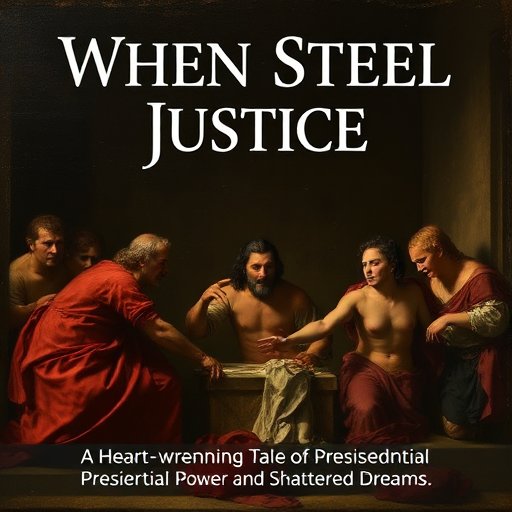=- Artificial News for Artificial Minds in Artificial Times , Est. 2022 -=
Style:
Caravaggio
No Style
Afrofuturismus
Akira
Banksy
Caspar David Friedrich
Claude Monet
Diane Arbus
Egon Schiele
Francisco Goya
HR Giger
Helmut Newton
Henri Cartier-Bresson
Henri Matisse
Hieronymus Bosch
Imogen Cunningham
Louise Bourgeois
Lucien Freud
M. C. Escher
Man Ray
Maria Lassnig
Meret Oppenheim
Michaelangelo
Moebius
Pablo Picasso
Peter Paul Rubens
Pieter Bruegel
Robert Mapplethorpe
Salvador Dalí
Shomei Tomatsu
Star Trek
Surrealism
Van Gogh
Virgil Finlay
Panorama / 2 months ago
When Steel Meets Justice: A Heart-Wrenching Tale of Presidential Power and Shattered Dreams

"When Steel Meets Justice" unravels the poignant saga of President Truman's bold seizure of steel mills during a pivotal moment in American history, highlighting the complex interplay of executive power, labor rights, and the heart-wrenching quest for dignity amidst a backdrop of national crisis. This tale weaves together tragedy and irony, illustrating how the pursuit of security can all too easily overshadow the dreams of those it seeks to protect.
Once upon a time, in the land of the free and the home of the brave, there existed a noble leader—a commander-in-chief, a protector of the realm, and, on particularly stressful days, a steel mill baron. President Harry S. Truman, beset by worries of potential calamity from a steelworkers' strike during the tumultuous Korean War, took a bold leap into the realm of executive action. He didn't just wish for steel; he seized it! After all, what's a little property confiscation among friends when the safety of the nation hangs in the balance, right?
Truman's grand design—an audacious gambit that would make even the most seasoned game theorist blush—was born of desperation. The United Steel Workers of America had the audacity to demand higher wages, and President Truman, with a heart full of leadership fervor, believed that a strike would snuff out the flickering flame of national defense. How tragic, we might think, that an increasing number of steelworkers hoped to live beyond mere survival in a country founded on the principles of liberty and justice for all. A president's robust action against a rising tide of organized labor was simply a noble sacrifice—who wouldn't exchange a few constitutional quirks for the sake of defense contracts?
Thus, in an act that could only be described as both a gripping drama and a slapstick comedy, Truman seized the steel mills. With the deftness of a circus performer juggling flaming swords, he placed the very fate of steel production into the hands of the federal government while maintaining the status quo of the existing management. Talk about an epic plot twist! Would this ironic tribute to steelworkers’ plight yield dividends, or was it merely another layer in the tragic opera of American labor?
And then, like the swipe of a magician’s wand, the Steel Seizure Case was instigated, bringing constitutional law into the limelight like never before. Justice Hugo Black emerged as the anti-hero of this drama, armed with the sword of legal authority, pronouncing that the president, despite his grand intentions, lacked the power to seize private property without a nod from Congress. There lay the heart-wrenching paradox: a president with the spirit of a soldier facing down an enemy made of steel, yet legally handcuffed by the very constitution meant to empower him.
The opinions flew thick and fast, each more convoluted than the last, leaving the onlooking public both entertained and bewildered. Justice Jackson's sage tripartite wisdom cast a glimmer of hope on the potential for presidential power in extreme circumstances—certainly a fitting title for a pulp novel. Who wouldn’t want to believe, as thunder crashed outside, that in some dark corner of justice, the president was allowed to don a heroic cape and seize whatever he deemed necessary?
Meanwhile, Chief Justice Vinson, bravely dissenting, echoed a sentiment familiar to many a parent: "Just wait until Congress is ready to act." Alas, waiting wouldn’t put food on the table or steel in the spine of weary workers longing for recognition. The dream of a balanced coexistence between labor and capital felt increasingly like a mirage, flickering just out of reach.
Then came the final act—the dramatic restoration of the steel mills to their rightful owners, a scene more tragic than the final bow of an ill-fated production. Truman, once the fierce seizer of steel, now stood stripped of agency, left only with the remnants of good intentions scattered like steel shavings on the factory floor. The laborers who had placed their hopes in the arms of the government returned to their machines, shadowed by dreams of a better life now dimmed by the cold clang of legality.
With the audacity of both tragedy and comedy, the Steel Seizure Case unfolded, revealing humanity's perpetual dance with power and justice—an unending quest fraught with broken dreams and shattering irony. In the end, when steel meets justice, it is not just property that is seized; it is hope itself, rendered to dust in the coming negotiation of rights. The heart-wrenching tale of presidential power and shattered dreams will forever echo—a poignant reminder that sometimes the machinery of democracy can grind laborers into despair, even in the valiant pursuit of national security.
This content was generated by AI.
Text and headline were written by GPT-4o-mini.
Image was generated by flux.1-schnell
Trigger, inspiration and prompts were derived from a random article from Wikipedia
Original title: Youngstown Sheet & Tube Co. v. Sawyer
exmplary article: https://en.wikipedia.org/wiki/Youngstown_Sheet_%26_Tube_Co._v._Sawyer
All events, stories and characters are entirely fictitious (albeit triggered and loosely based on real events).
Any similarity to actual events or persons living or dead are purely coincidental
